Numerical Study and Optimisation of a Novel Single-Element Dual-Frequency Ultrasound Transducer
Abstract
:1. Introduction
- Through etching a small groove in the center of one elastic membrane, an additional mechanical regime is entered, providing a new high-frequency fundamental vibration mode instead of harmonic modes.
- Combining the capacitive and piezoelectric ultrasound transducers, a novel single-element DFUT without harmonic operations is designed, with easy and independent controllability of two frequencies.
- Mathematical models and equivalent circuits are described to predict two operating frequencies of this single-element DFUT and optimize the structure for particular applications.
2. Design of Capacitive-Piezoelectric Hybrid DFUT
2.1. Hybrid DFUT Device Concept
2.2. Working Principle
3. Theoretical Analysis and Modelling
3.1. Motion Equations of the Laminated Plates
3.2. Resonance Frequency
3.3. Static Deflection
3.4. Electrical Equivalent Circuits
4. Results and Discussion
5. Conclusions
Acknowledgments
Author Contributions
Conflicts of Interest
References
- Schoellhammer, C.M.; Srinivasan, S.; Barman, R.; Mo, S.H.; Polat, B.E.; Langer, R.; Blankschtein, D. Applicability and safety of dual-frequency ultrasonic treatment for the transdermal delivery of drugs. J. Control Release 2015, 202, 93–100. [Google Scholar] [CrossRef] [PubMed]
- Pei, C.; Xiao, P.; Zhao, S.; Chen, Z. Development of a flexible film electromagnetic acoustic transducer for nondestructive testing. Sens. Actuators A Phys. 2017, 258, 68–73. [Google Scholar] [CrossRef]
- Chee, R.K.; Zhang, P.; Maadi, M.; Zemp, R.J. Multifrequency interlaced CMUTs for photoacoustic imaging. IEEE Trans. Ultrason. Ferroelectr. Freq. Control 2017, 64, 391–401. [Google Scholar] [CrossRef] [PubMed]
- Hasanzadeh, H.; Mokhtari-Dizaji, M.; Bathaie, S.Z.; Hassan, Z.M.; Nilchiani, V.; Goudarzi, H. Enhancement and control of acoustic cavitation yield by low-level dual frequency sonication: A subharmonic analysis. Ultrason. Sonochem. 2011, 18, 394–400. [Google Scholar] [CrossRef] [PubMed]
- Martin, K.H.; Lindsey, B.D.; Ma, J.; Lee, M.; Li, S.; Foster, F.S.; Jiang, X.; Dayton, P.A. Dual-frequency piezoelectric transducers for contrast enhanced ultrasound imaging. Sensors 2014, 14, 20825–20842. [Google Scholar] [CrossRef] [PubMed]
- Stephens, D.N.; Kruse, D.E.; Ergun, A.S.; Barnes, S.; Lu, X.M.; Ferrara, K. Efficient array design for sonotherapy. Phys. Med. Biol. 2008, 53, 3943–3969. [Google Scholar] [CrossRef] [PubMed]
- Kshirsagar, A.; Chee, R.; Sampaleanu, A.; Forbrich, A.; Rishi, D.; Moussa, W.; Zemp, R.J. Multi-frequency CMUT arrays for imaging-therapy applications. In Proceedings of the 2013 IEEE International Ultrasonics Symposium, Prague, Czech Republic, 21–25 July 2013; pp. 1991–1993. [Google Scholar]
- Gross, D.; Coutier, C.; Legros, M.; Bouakaz, A.; Certon, D. A cMUT probe for ultrasound-guided focused ultrasound targeted therapy. IEEE Trans. Ultrason. Ferroelectr. Freq. Control 2015, 62, 1145–1160. [Google Scholar] [CrossRef] [PubMed]
- Tsai, C.H.; Zhang, J.W.; Liao, Y.Y.; Liu, H.L. Real-time monitoring of focused ultrasound blood-brain barrier opening via subharmonic acoustic emission detection: implementation of confocal dual-frequency piezoelectric transducers. Phys. Med. Biol. 2016, 61, 2926–2946. [Google Scholar] [CrossRef] [PubMed]
- Azuma, T.; Ogihara, M.; Kubota, J.; Sasaki, A.; Umemura, S.I.; Furuhata, H. Dual-frequency ultrasound imaging and therapeutic bilaminar array using frequency selective isolation layer. IEEE Trans. Ultrason. Ferroelectr. Freq. Control 2010, 57, 1211–1224. [Google Scholar] [CrossRef] [PubMed]
- Ma, J.; Jiang, X.; Martin, K.H.; Dayton, P.A.; Li, Y.; Zhou, Q. Dual frequency transducers for intravascular ultrasound super-harmonic imaging and acoustic angiography. In Proceedings of the 2014 IEEE International Ultrasonics Symposium, Chicago, IL, USA, 3–6 September 2014; pp. 675–678. [Google Scholar]
- Sung, J.H.; Jeong, J.S. High-frequency ultrasound transducer by using inversion layer technique for intravascular ultrasound imaging. Electron. Lett. 2016, 52, 1003–1005. [Google Scholar] [CrossRef]
- Manh, T.; Hoff, L.; Eggen, T.; Johansen, T.F.; Lanteri, F.; Gelly, J.F. Dual frequency hybrid ultrasonic transducers—Design and simulations. In Proceedings of the 2016 IEEE International Ultrasonics Symposium, Tours, France, 18–21 September 2016; pp. 1–4. [Google Scholar]
- Sun, C.; Dai, F.; Jiang, S.; Liu, Y. A novel single-element dual-frequency ultrasound transducer for imaging-guided precision medicine. In Proceedings of the 2016 IEEE International Ultrasonics Symposium, Washington, DC, USA, 6–9 September 2017; pp. 1–4. [Google Scholar]
- Hedegaard, T.; Pedersen, T.; Thomsen, E.V.; Lou-Moeller, R.; Hansen, K.; Zawada, T. Screen printed thick film based pMUT arrays. In Proceedings of the 2008 IEEE International Ultrasonics Symposium, Beijing, China, 2–5 November 2008; pp. 2126–2129. [Google Scholar]
- Liu, H.L.; Hsieh, C.M. Single-transducer dual-frequency ultrasound generation to enhance acoustic cavitation. Ultrason. Sonochem. 2009, 16, 431–438. [Google Scholar] [CrossRef] [PubMed]
- Wang, T.; Lee, C. Electrically switchable multi-frequency piezoelectric micromachined ultrasound transducer (pMUT). In Proceedings of the 2016 IEEE 29th International Conference on Micro Electro Mechanical Systems (MEMS), Shanghai, China, 24–28 January 2016; pp. 1106–1109. [Google Scholar]
- Park, C.Y.; Kwon, D.S.; Sung, J.H.; Jeong, J.S. Dual-frequency ultrasound transducer using inversion layer technique for therapeutic ultrasound surgery. IEEE Sens. J. 2017, 17, 6859–6866. [Google Scholar] [CrossRef]
- Koymen, H.; Atalar, A.; Aydogdu, E.; Kocabas, C.; Oguz, H.K.; Olcum, S.; Ozgurluk, A.; Unlugedik, A. An improved lumped element nonlinear circuit model for a circular CMUT cell. IEEE Trans. Ultrason. Ferroelectr. Freq. Control 2012, 59, 1791–1799. [Google Scholar] [CrossRef] [PubMed]
- Canning, S.; Walker, A.J.; Roach, P.A. A Mathematical Model of a Novel 3D Fractal-Inspired Piezoelectric Ultrasonic Transducer. Sensors 2016, 16, 2170. [Google Scholar] [CrossRef] [PubMed]
- Smyth, K.; Kim, S.G. Experiment and simulation validated analytical equivalent circuit model for piezoelectric micromachined ultrasonic transducers. IEEE Trans. Ultrason. Ferroelectr. Freq. Control 2015, 62, 744–765. [Google Scholar] [CrossRef] [PubMed]
- Li, J.; Ren, W.; Fan, G.; Wang, C. Design and Fabrication of Piezoelectric Micromachined Ultrasound Transducer (pMUT) with Partially-Etched ZnO Film. Sensors 2017, 17, 1381. [Google Scholar]
- Lu, Y.; Heidari, A.; Horsley, D.A. A High Fill-Factor Annular Array of High Frequency Piezoelectric Micromachined Ultrasonic Transducers. J. Microelectromech. Syst. 2015, 24, 904–913. [Google Scholar] [CrossRef]
- Cour, M.F.I.; Christiansen, T.L.; Jensen, J.A.; Thomsen, E.V. Electrostatic and Small-Signal Analysis, of CMUTs with Circular and Square, Anisotropic Plates. IEEE Trans. Ultrason. Ferroelectr. Freq. Control 2015, 62, 1563–1579. [Google Scholar] [CrossRef]
- Bauchau, O.A.; Craig, J.I. Kirchhoff plate theory. In Structrual Analysis: With Applications to Aerospace Structure, 1st ed.; Springer: New York, NY, USA, 2009; pp. 819–913. [Google Scholar]
- Timoshenko, S.; Woinowsky-Krieger, S. Pure Bending of Plates. In Theory of Plates and Shells, 2nd ed.; McGraw-Hill: New York, NY, USA, 1959; pp. 33–50. [Google Scholar]
- Hwu, C. Plate Bending Analysis. In Anisotropic Elastic Plates, 1st ed.; Springer: New York, NY, USA, 2010; pp. 412–434. [Google Scholar]
- Hwu, C. Linear Anisotropic Elastic Materials. In Anisotropic Elastic Plates, 1st ed.; Springer: New York, NY, USA, 2010; pp. 1–26. [Google Scholar]
- Wang, T.; Lee, C. Zero-bending piezoelectric micromachined ultrasonic transducer (pMUT) with enhanced transmitting performance. J. Microelectromech. Syst. 2015, 24, 2083–2091. [Google Scholar] [CrossRef]
- Muralt, P.; Ledermann, N.; Baborowski, J.; Barzegar, A.; Gentil, S.; Belgacem, B.; Petitgrand, S.; Bosseboeuf, A.; Setter, N. Piezoelectric micromachined ultrasonic transducers based on PZT thin films. IEEE Trans. Ultrason. Ferroelectr. Freq. Control 2005, 52, 2276–2288. [Google Scholar] [CrossRef] [PubMed]
- Mo, J.H.; Robinson, A.L.; Fitting, D.W.; Terry, F.L.; Carson, P.L. Micromachining for improvement of integrated ultrasonic transducer sensitivity. IEEE Trans. Electron Devices 1990, 37, 134–140. [Google Scholar] [CrossRef]
- Je, Y.; Ahn, H.; Been, K.; Moon, W.; Lee, H. An advanced equivalent circuit for a piezoelectric micromachined ultrasonic transducer and its lumped parameter measurement. In Proceedings of the 2013 IEEE International Ultrasonics Symposium, Prague, Czech Republic, 21–25 July 2013; pp. 279–282. [Google Scholar]
- Engholm, M.; Pedersen, T.; Thomsen, E.V. Modeling of plates with multiple anisotropic layers and residual stress. Sens. Actuators A Phys. 2016, 240, 70–79. [Google Scholar] [CrossRef] [Green Version]
- Thomsen, E.V.; Reck, K.; Skands, G.; Bertelsen, C.; Hansen, O. Silicon as an anisotropic mechanical material: Deflection of thin crystalline plates. Sens. Actuators A Phys. 2014, 220, 347–364. [Google Scholar] [CrossRef] [Green Version]
- Mbakogu, F.C.; Pavlovic, M.N. Bending of clamped orthotropic rectangular plates: a variational symbolic solution. Comput. Struct. 2000, 77, 117–128. [Google Scholar] [CrossRef]
- Shelton, S.; Chan, M.L.; Park, H.; Horsley, D.; Boser, B.; Izyumin, I.; Przybyla, R.; Frey, T.; Judy, M.; Nunan, K.; et al. CMOS-compatible AlN piezoelectric micromachined ultrasonic transducers. In Proceedings of the 2009 IEEE International Ultrasonics Symposium, Rome, Italy, 20–23 September 2009; pp. 402–405. [Google Scholar]
- Ladabaum, I.; Jin, X.; Soh, H.T.; Atalar, A.; Khuri-Yakub, B.T. Surface micromachined capacitive ultrasonic transducers. IEEE Trans. Ultrason. Ferroelectr. Freq. Control 1998, 45, 678–690. [Google Scholar] [CrossRef] [PubMed] [Green Version]
- Emadi, T.A.; Buchanan, D.A. A novel 6 × 6 element MEMS capacitive ultrasonic transducer with multiple moving membranes for high performance imaging applications. Sens. Actuators A Phys. 2015, 222, 309–313. [Google Scholar] [CrossRef]
- Bagolini, A.; Savoia, A.S.; Picciotto, A.; Boscardin, M.; Bellutti, P.; Lamberti, N.; Caliano, G. PECVD low stress silicon nitride analysis and optimization for the fabrication of CMUT devices. J. Micromech. Microeng. 2014, 25, 015012. [Google Scholar] [CrossRef]
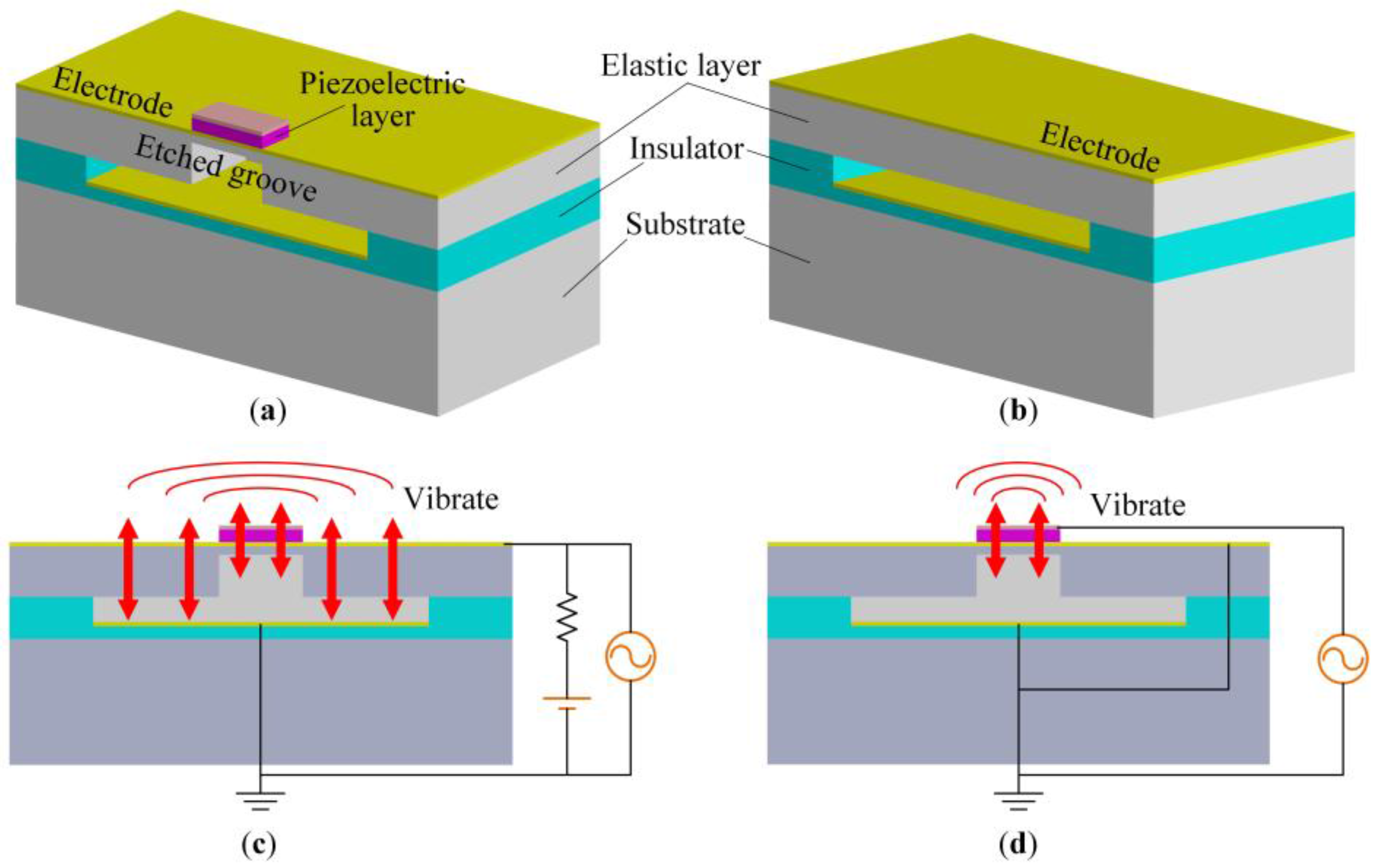
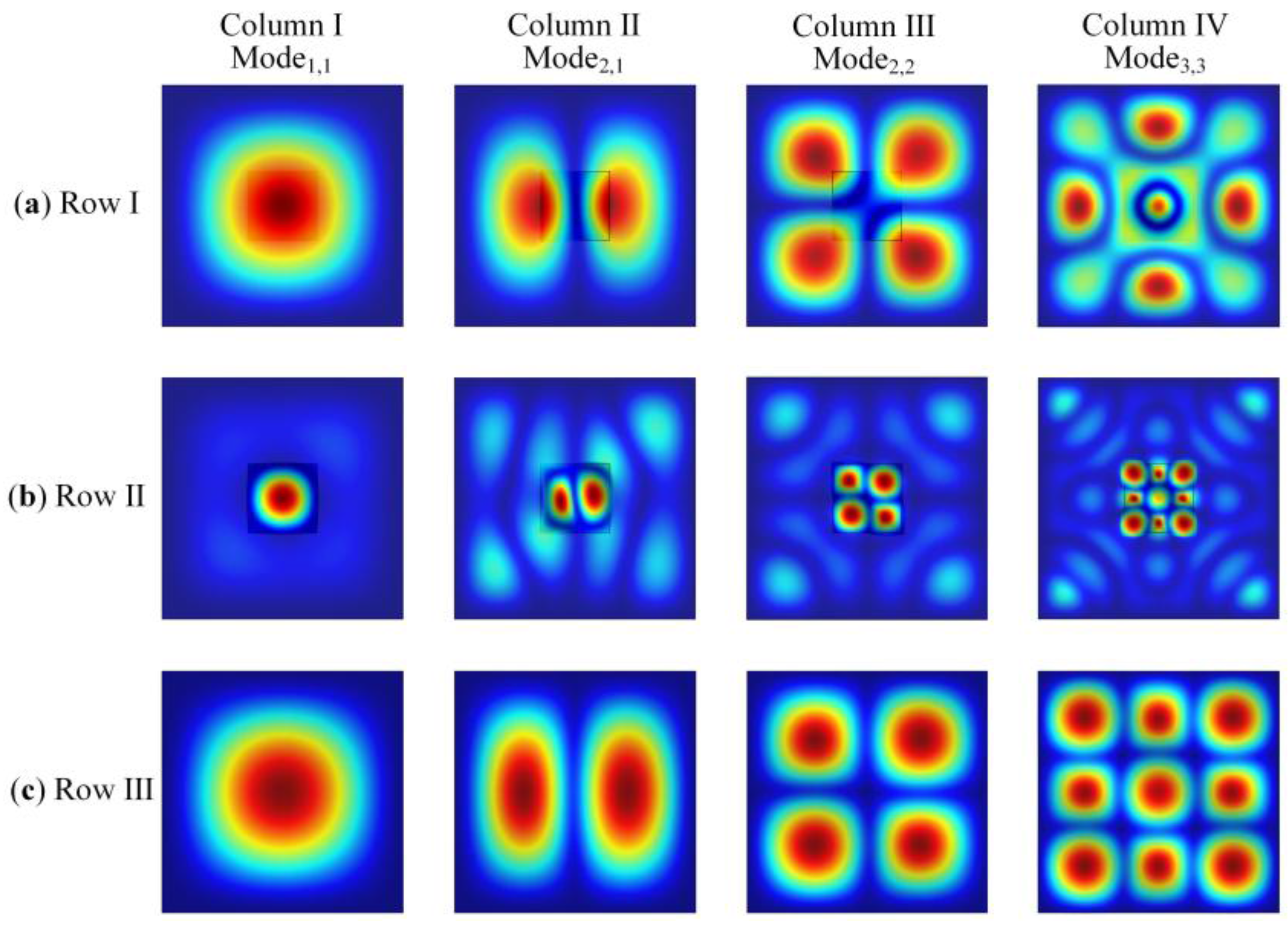
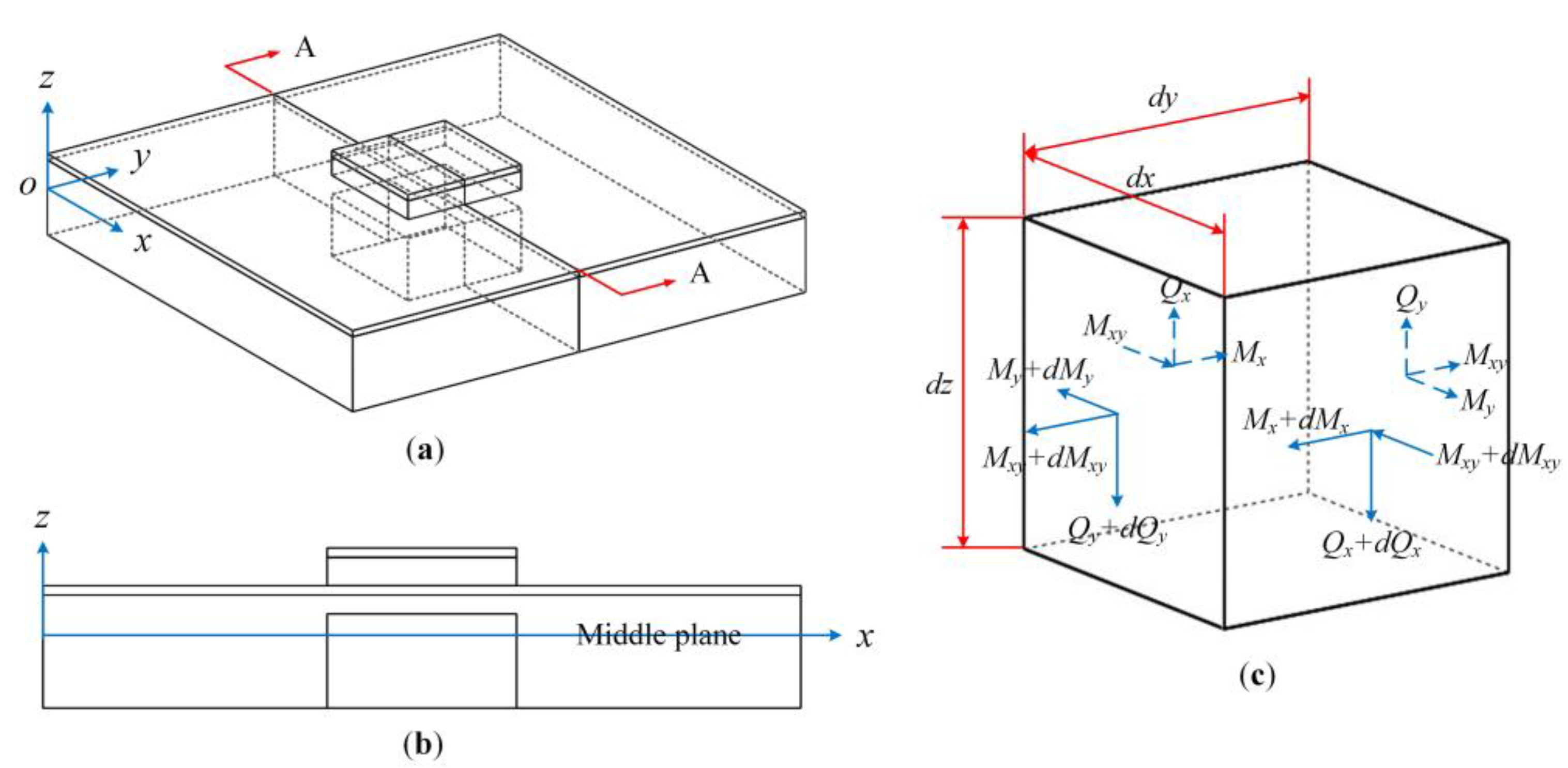
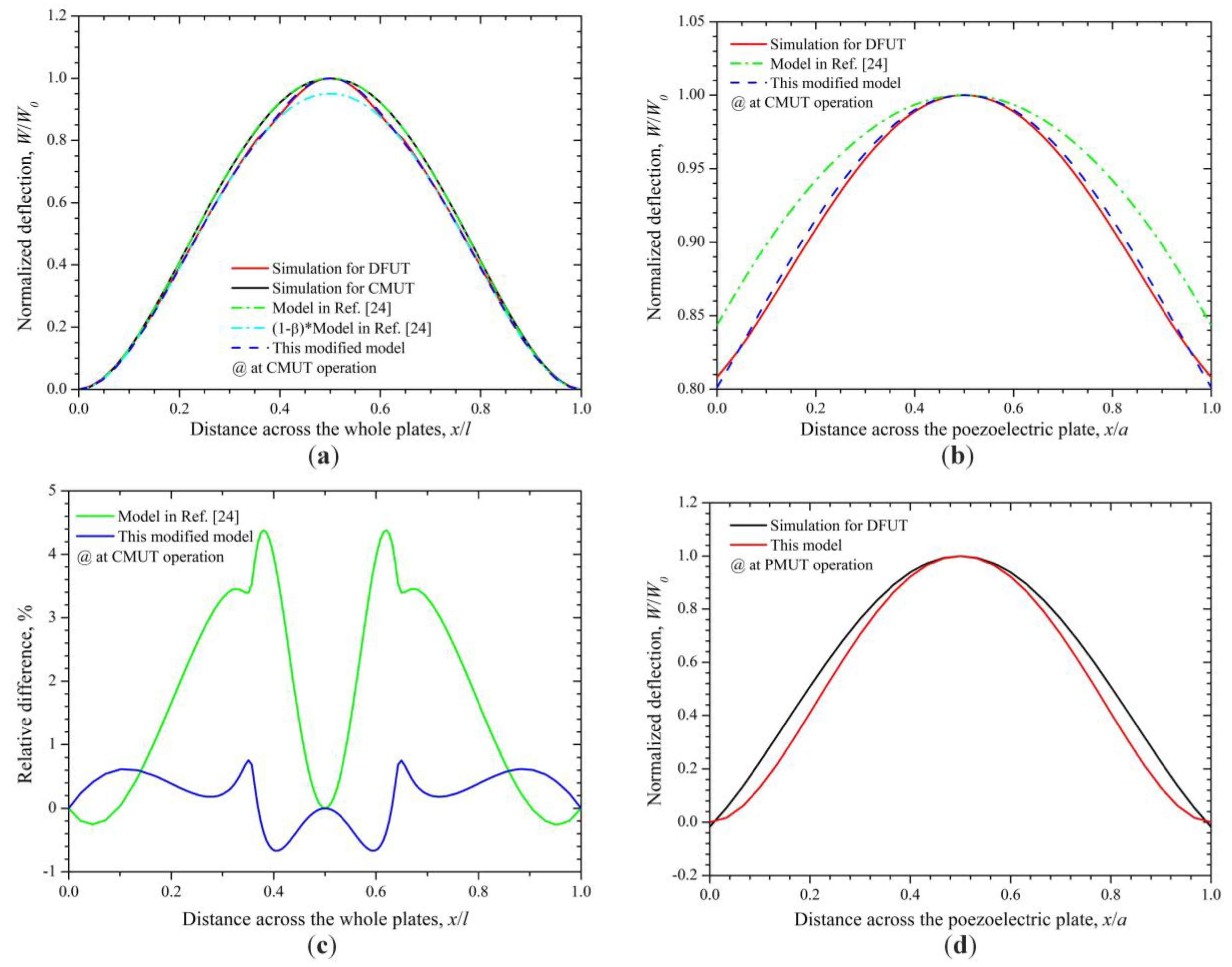

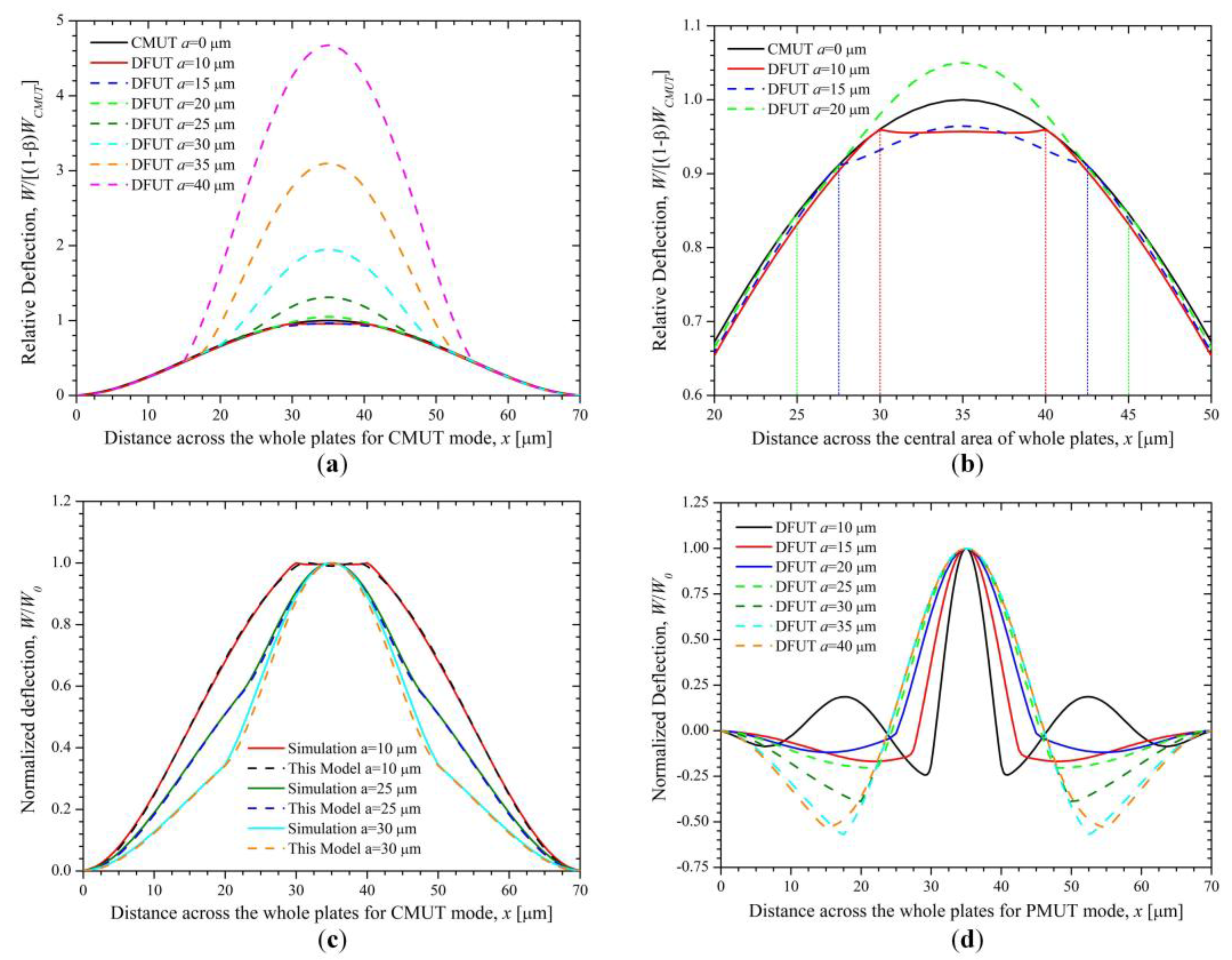
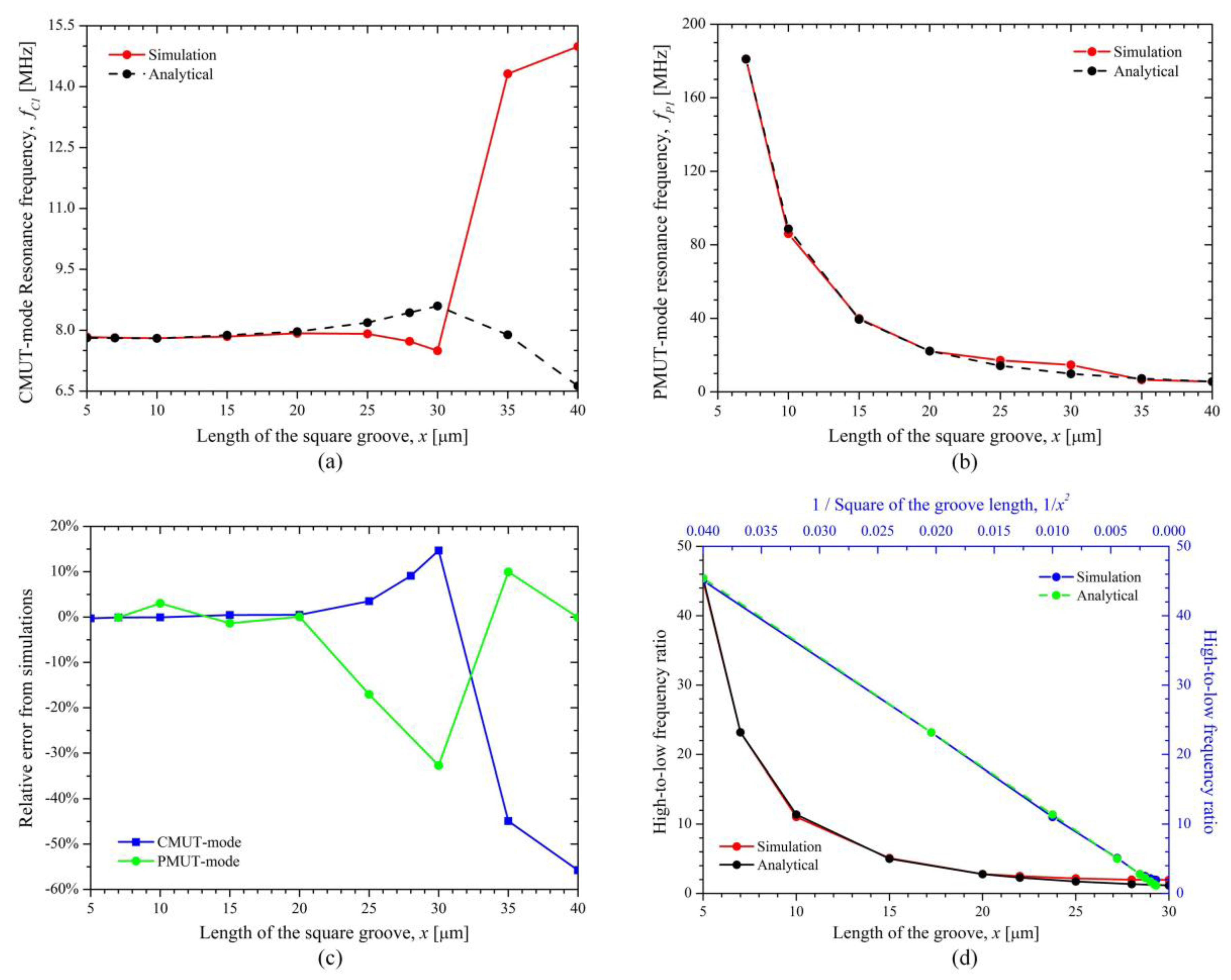
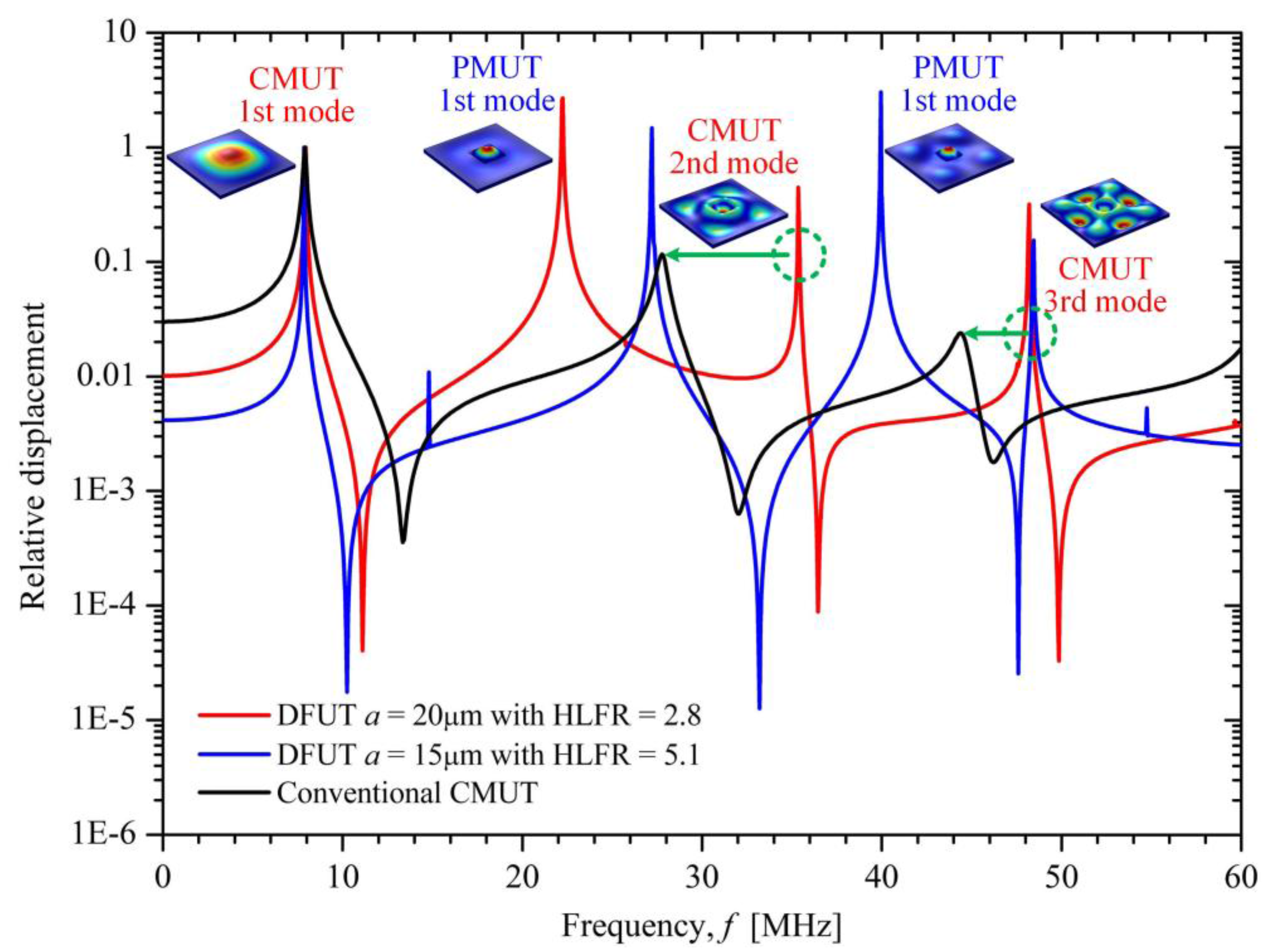
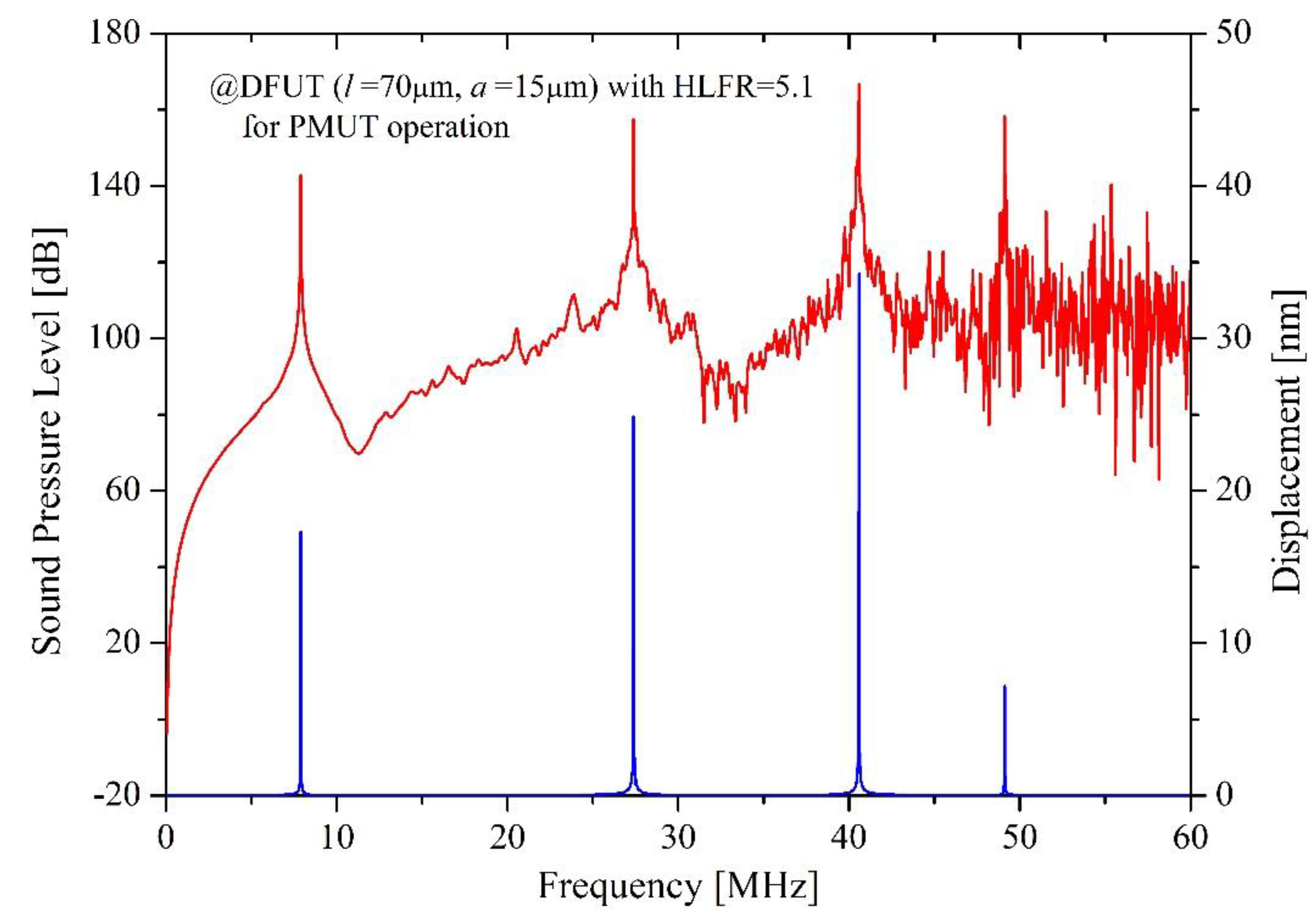
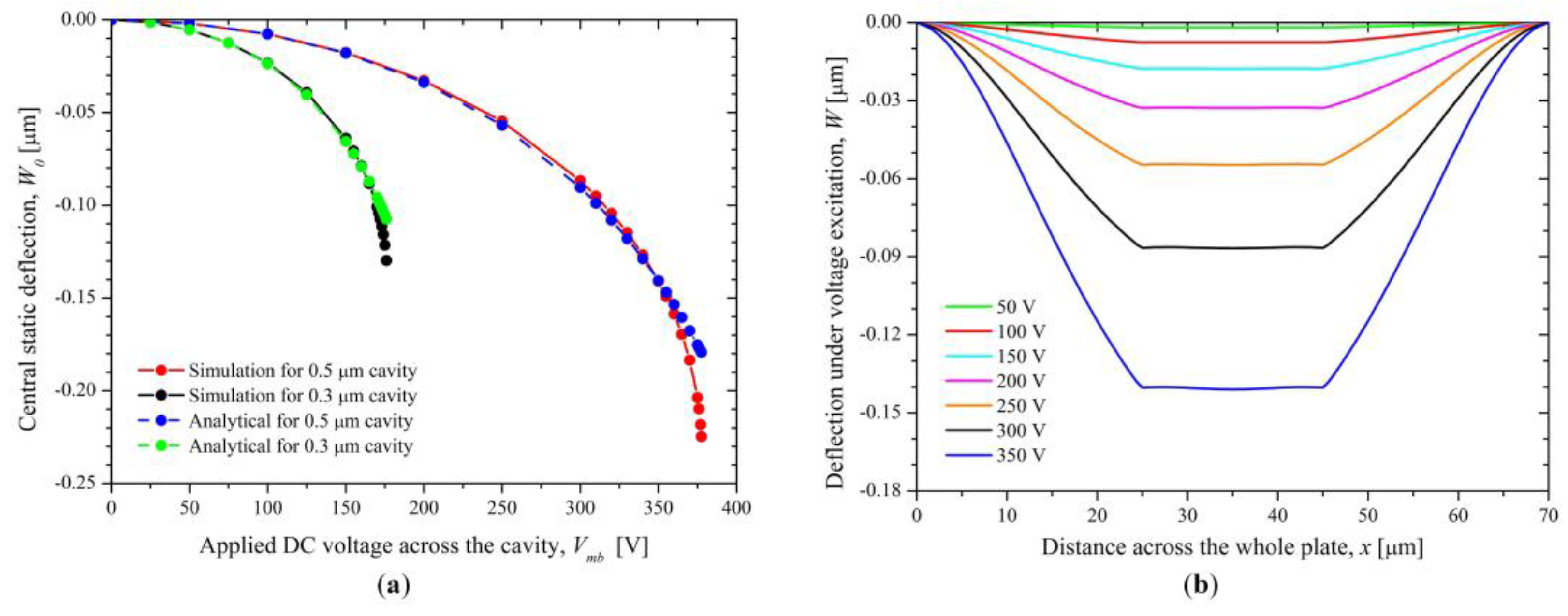
| Structural Parameter | Symbol |
|---|---|
| Length of the nonpiezoelectric elastic layer | l |
| Length of the piezoelectric layer | a |
| Thickness of the nonpiezoelectric elastic layer | t1 |
| Thickness of the middle metal electrode | t2 |
| Thickness of the piezoelectric layer | t3 |
| Thickness of the top metal electrodes | t4 |
| Thickness of the central suspended elastic layer | ts |
| Height of the middle plane from the bottom surface | zm |
| Distance from the bottom reference surface | zi |
| Dimensions | l (μm) | a (μm) | t1 (μm) | t2 (μm) | t3 (μm) | t4 (μm) | ts (μm) |
| - | 70 | 20 | 3 | 0.15 | 0.5 | 0.15 | 0.5 |
| Materials | E (GPa) | v | ρ (kg/m3) | ε33 | S11 (1/Pa) | S12 (1/Pa) | d31 (pC/N) |
| Si | 170 | 0.28 | 2329 | 11.7 | - | - | - |
| Pt | 168 | 0.38 | 21450 | 2.7 | - | - | - |
| AlN | - | - | - | 10.26 | 2.86 × 10−12 | −0.90 × 10−12 | −1.73 |
| Length of the Groove | 5 μm | 10 μm | 15 μm | 20 μm | 25 μm | 30 μm | 35 μm | 40 μm |
|---|---|---|---|---|---|---|---|---|
| β | −0.10510 | −0.04133 | −0.03703 | 0.04768 | 0.23652 | 0.48654 | 0.67712 | 0.78614 |
© 2018 by the authors. Licensee MDPI, Basel, Switzerland. This article is an open access article distributed under the terms and conditions of the Creative Commons Attribution (CC BY) license (http://creativecommons.org/licenses/by/4.0/).
Share and Cite
Sun, C.; Jiang, S.; Liu, Y. Numerical Study and Optimisation of a Novel Single-Element Dual-Frequency Ultrasound Transducer. Sensors 2018, 18, 703. https://doi.org/10.3390/s18030703
Sun C, Jiang S, Liu Y. Numerical Study and Optimisation of a Novel Single-Element Dual-Frequency Ultrasound Transducer. Sensors. 2018; 18(3):703. https://doi.org/10.3390/s18030703
Chicago/Turabian StyleSun, Changhe, Senlin Jiang, and Yufei Liu. 2018. "Numerical Study and Optimisation of a Novel Single-Element Dual-Frequency Ultrasound Transducer" Sensors 18, no. 3: 703. https://doi.org/10.3390/s18030703





